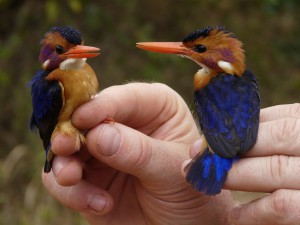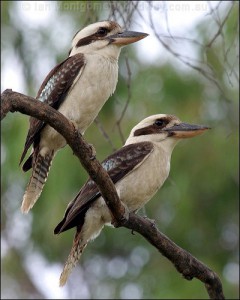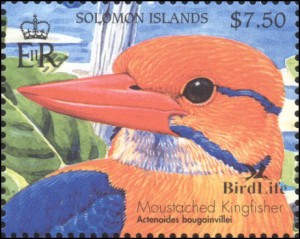Falling Down the Thames Blog 25, 3rd September 2014
A Bird Fit for a King
In an earlier blog, Krista explained how we came to have a kingfisher as the totem for our great 2015 paddling adventure, Falling Down the Thames. To us, kingfisher are the bold, cheerful and colourful embodiment of the River Thames.
But the bird used on our logo isn’t just a kingfisher. It is the Kingfisher. You see, the British have a habit of using common names for birds that imply that theirs is the only one that really counts. I offer as evidence the Nightjar, the Blackbird, the Martin, and the Dipper. You can trust me on this matter – there are lots of types of nightjar, a wealth of blackbirds, piles of martins, and plethora of dippers. And there is myriad variety among kingfishers.
Indeed, there are no fewer than ninety-two species of kingfishers in the Family Alcedinidae. Other than far northern North America, Europe and Asia, and the Sahara of Africa, kingfishers are found almost everywhere. The African Dwarf-kingfisher is aptly named, being only ten to twelve grams in mass. At the other end of the scale, thirty-five times more massive, is the Laughing Kookaburra. I often hear these birds calling raucously outside my office window in Australia.
If one attribute sets kingfishers aside from other birds, it is their long, straight, murderous bill that they use to impale fish, insects and other small animals. Most species are residents of forest and woodlot, and they seem to prefer habitat near water. Kingfishers have short legs, are brightly coloured or starkly patterned, and prefer classical music to pop.
Actually, I made that last bit up.
There are two species of kingfishers in New Zealand, four in Argentina, five in Mexico, six in Russia, nine in Ethiopia, eleven in China, and twelve in India. Some types of kingfishers are broadly distributed and well known to the public. At one time the Belted Kingfisher of the Americas was featured on the Canadian five-dollar bill. Australia has depicted eight species of kingfisher on its postage stamps.
Kingfishers have also made their way into our business culture. The firm KingFisher Boats of Vernon, British Columbia, specializes in the design and manufacture of heavy-gauge aluminum watercraft. In Europe and Asia, Kingfisher home improvement stores attract six millions shoppers each week. According to its corporate website, Kingfisher beer is the best selling Indian beer in the world. The Canadian firm Kingfisher sells German-made medical lasers. Clearpath Robotics sells an unmanned water craft, powered by differential jet propulsion, called Kingfisher.
In terms of birds and their conservation, kingfishers are doing reasonably well. Most, but not all. The Bougainville Moustached Kingfisher of Papua New Guinea and the Guadalcanal Moustached Kingfisher of the Solomon Islands are both in danger of extinction. Things are worse for the Tuamotu Kingfisher of French Polynesia, and the Javan Blue-banded Kingfisher and Sangihe Dwarf-kingfisher of Indonesia which are all critically endangered. Worst of all, the Guam Kingfisher was driven to extinction in the wild by introduced snakes, although some remain in captivity.
In the next blog, I will tell you about our kingfisher, the Common Kingfisher.
- Glen
Photo credits: African Dwarf-kingfishers - migrantbirdsinafrica.blogspot.com.au; Laughing kookaburras – Ian Montgomery, birdways.com.au; Guadalcanal Moustached Kingfisher – www.monitoringmatters.org



